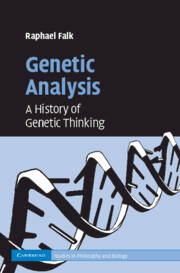Book contents
- Frontmatter
- Contents
- List of figures
- Acknowledgments
- Introduction
- PART I FROM REPRODUCTION AND GENERATION TO HEREDITY
- PART II FAKTOREN IN SEARCH OF MEANING
- PART III THE CHROMOSOME THEORY OF INHERITANCE
- PART IV GENES AS THE ATOMS OF HEREDITY
- 8 Characterizing the gene
- 9 Analysis of the gene by mutations
- 10 From evolution to population genetics
- PART V INCREASING RESOLVING POWER
- PART VI DEDUCING GENES FROM TRAITS, INDUCING TRAITS FROM GENES
- PART VII WHAT IS TRUE FOR E. COLI IS NOT TRUE FOR THE ELEPHANT
- Concluding comments
- Bibliography
- Index
10 - From evolution to population genetics
Published online by Cambridge University Press: 07 August 2009
- Frontmatter
- Contents
- List of figures
- Acknowledgments
- Introduction
- PART I FROM REPRODUCTION AND GENERATION TO HEREDITY
- PART II FAKTOREN IN SEARCH OF MEANING
- PART III THE CHROMOSOME THEORY OF INHERITANCE
- PART IV GENES AS THE ATOMS OF HEREDITY
- 8 Characterizing the gene
- 9 Analysis of the gene by mutations
- 10 From evolution to population genetics
- PART V INCREASING RESOLVING POWER
- PART VI DEDUCING GENES FROM TRAITS, INDUCING TRAITS FROM GENES
- PART VII WHAT IS TRUE FOR E. COLI IS NOT TRUE FOR THE ELEPHANT
- Concluding comments
- Bibliography
- Index
Summary
Mendelian nomenclature of symbolic representation of genes and their alleles makes it readily amenable to algebraic presentation of population events. Mendel himself was the first to take notice of this when he explained Gärtner's and Kölreuter's observations “that hybrids have a tendency to revert to parental forms” in algebraic terms:
If one assumes, on the average, equal fertility for all plants in all generations, and if one considers, furthermore, that half of the seeds that each hybrid produces yield hybrids again while in the other half the two traits become constant in equal proportions, then the numerical relationships for the progeny in each generation follow from the tabulation …
Mendel, in Stern and Sherwood (1966, 16)In the last line of the tabulation Mendel generalized the results for the nth generation of selfing that follows mono-hybridization: the ratio of “A : Aa : a” would be 2n−1 : 2 : 2n−1.
Bateson adopted Mendel's hypothesis upon reading de Vries's paper because he believed that it was consistent with his notion of evolution by discontinuous steps. This placed him in opposition to the claim of the mathematical statistician Karl Pearson in favor of Galton's “Law of Ancestral Heredity” of continuous Darwinian evolution (Provine, 1971; and see Chapter 3). In a discussion following a talk by Bateson's colleague Punnett, it was suggested that “a dominant allele, once introduced into a population, would increase in frequency until reaching stability at 0.5, given the usual phenotypic ratio 3 dominant: 1 recessive thereafter” (Provine, 1971, 133–134).
- Type
- Chapter
- Information
- Genetic AnalysisA History of Genetic Thinking, pp. 158 - 170Publisher: Cambridge University PressPrint publication year: 2009



